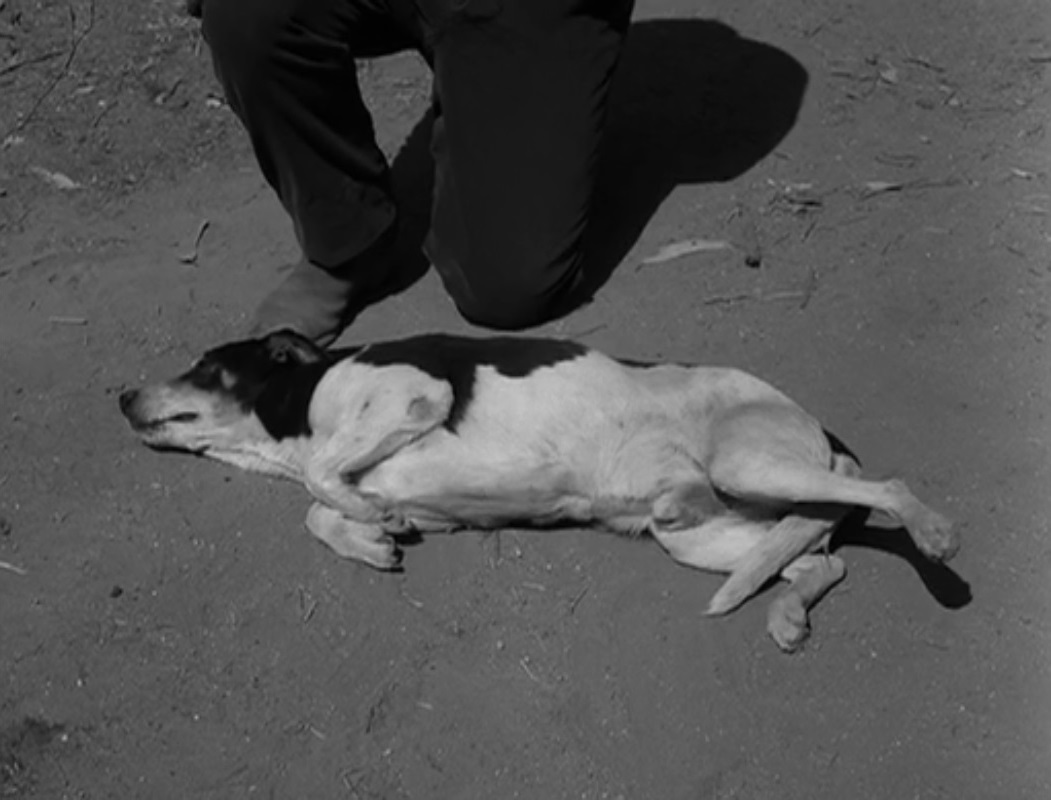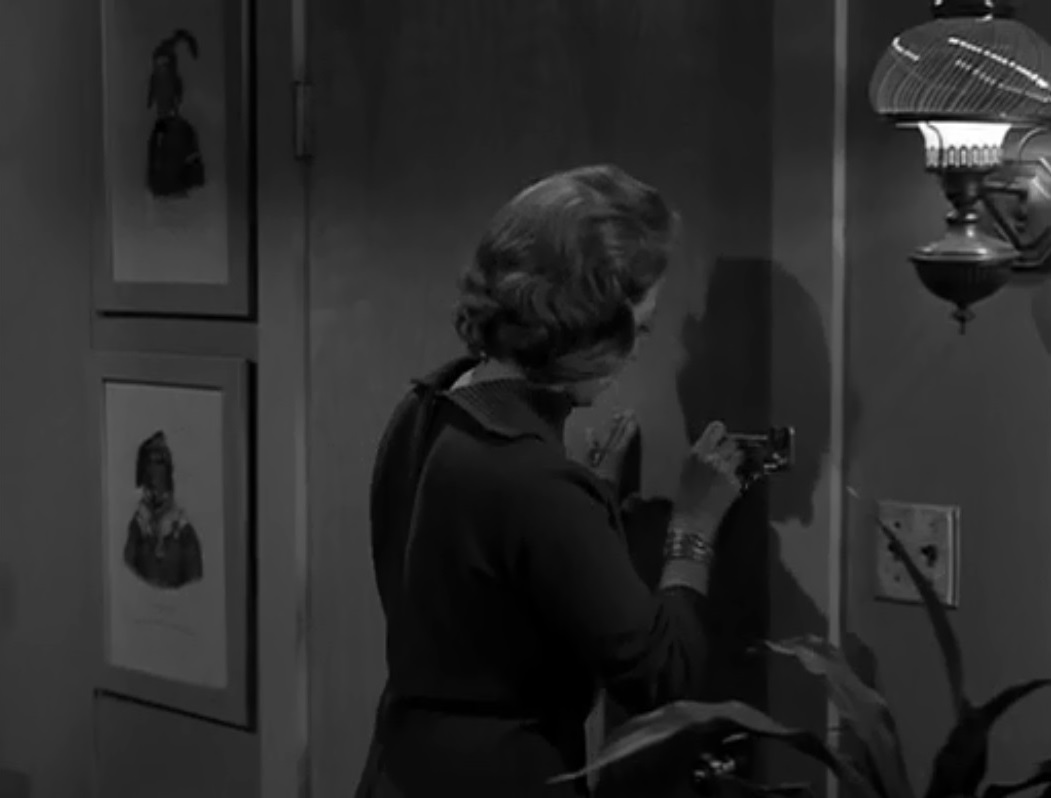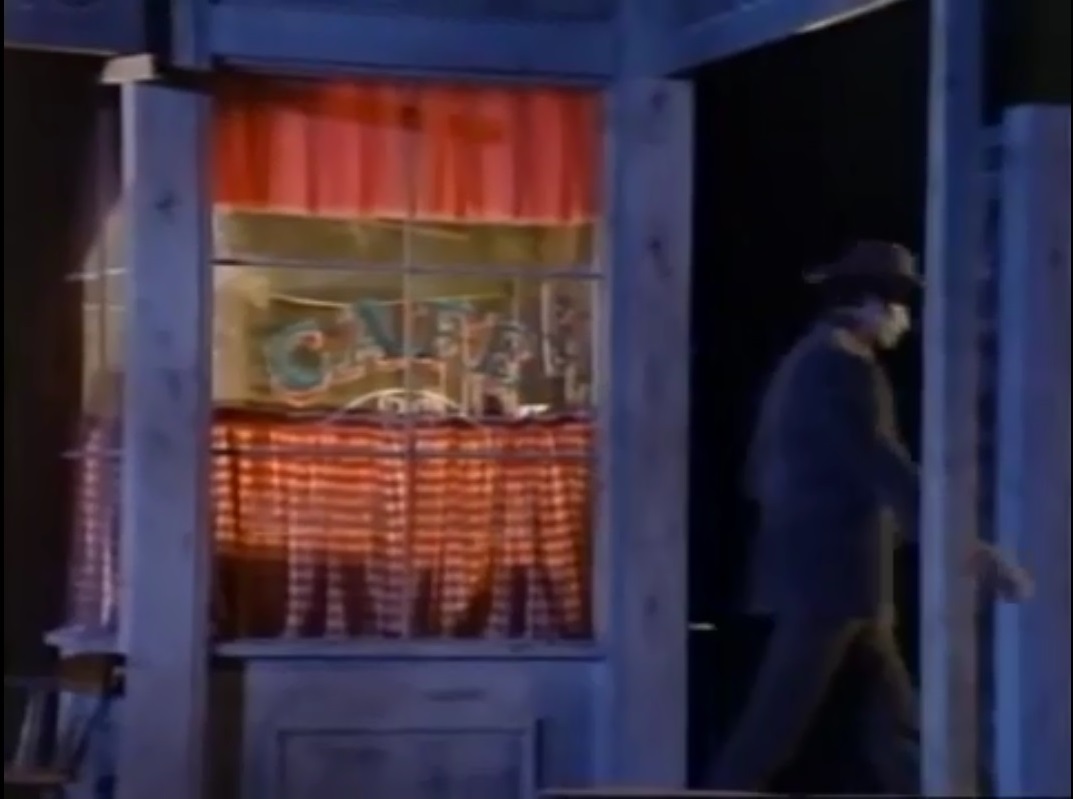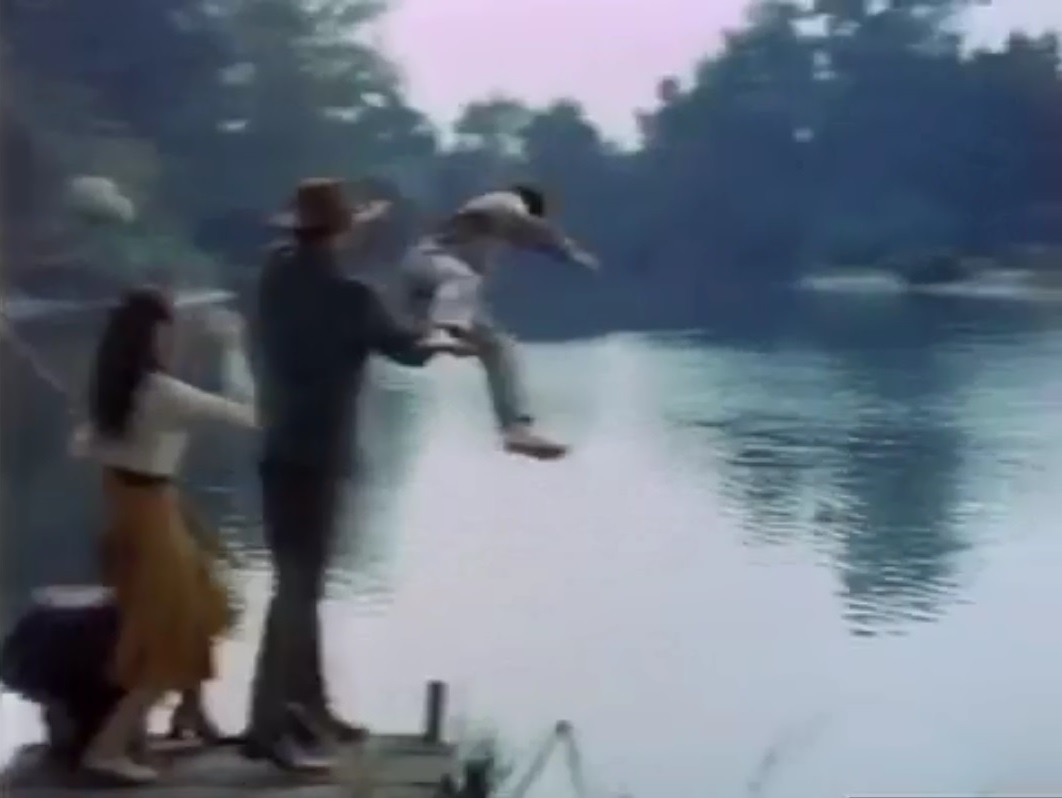The
Case of the Moth-Eaten Mink
Perry Mason
Behind
its label is a pawn ticket (Globe Pawn Shop, Portland, Or.) for a .38 Smith
& Wesson belonging to a late rookie policeman shot
with it by his superior, a detective sergeant who secretly owns a downtown Los
Angeles hotel used as a criminal headquarters. Post treats
this heftily in true film noir style, close to the camera or lavishly
dressed for richness or compression, denuded in light or dark for a hospital
corridor or hotel room.
The Case of the Sun
Bather’s Diary
Perry Mason
The
choice opening, in which the sun bather returns to her
trailer only to find it missing with her diary inside, mirrors the crime at issue,
which may be taken as a satire of the medical profession. A company
doctor’s office is used to filch keys from patients’ clothing so as to rob an armored car shipment by replacing a gunny
sack of cash with one full of canceled checks.
Hamilton
Burger actually does indict Mason for perjury in another reflection of the
theme (hiding two stolen bills in a window shade, which action is amusingly misunderstood by Burger to have been a signal).
Not only is the charge refuted by Mason on the witness stand at a murder trial,
from that vantage point he solves the entire case.
In
complete contrast to “The Case of the Moth-Eaten Mink”,
Post’s treatment is thematically sunny.
A World of Difference
The Twilight Zone

Baudelaire’s
prose poem “La chambre double”, translated into Hollywood by
way of Cukor’s A Double Life and Capra’s It’s a
Wonderful Life (which is directly cited twice), with its “infâme
concubine qui vient crier misère” an ex-wife screaming for alimony, a
“harpy”, and the entire structure so firmly divided as to raise all
manner of speculation.
On, for instance, the artist and his commentators, with great
vehemence of point.
Fellini obtrudes a camera and shows the set in E la nave va,
similarly. Post has a spectacular coup in a continuous shot as Howard Duff
perfectly attuned to this part enters the office set through the absent fourth
wall and pleads, “don’t leave me here.” The lights come up, he turns and sees the wall in place with a sunlit
window.
One of a number of episodes treating the theme in all its
aspects, characteristically. “Where Is Everybody?” (dir.
Robert Stevens) pictures Whitman in an uncreated world with a fourth wall of
observers. “The Trouble with Templeton” (dir. Buzz Kulik) is a round-trip to the past, which has its own
script. “Static” (dir. Buzz Kulik) treats
of the permanence of art. “A Stop at Willoughby” (dir. Robert
Parrish) sees an escape from life. “People Are Alike All Over”
(dir. Mitchell Leisen) re-creates an Earth habitat in a Martian zoo. “The
Sixteen-Millimeter Shrine” (dir. Mitchell Leisen) is closest of all, the artist exists in his work. Sternberg’s The Blue Angel is decisive for the
return to the set as it is being struck, The Private World of Arthur Curtis has
ceased production, “Arthur Curtis is
dead,” the actor is thought to be having a nervous breakdown. The company
executive, Arthur Curtis, encounters a little girl who flees from him, a
theatrical agent and a supposed ex-wife are “after his blood”, grips take the office furniture away,
|
With the voices singing in our
ears, saying That this was all folly |
he
takes his wife on a jet to San Francisco for the vacation they haven’t had
in years, the one he is arranging in the opening scene before the wall in his
office opens to reveal a camera crew. “I just don’t want to lose
you,” he says, a line remembered by Pinter at the close of Kazan’s The Last Tycoon. “L’Amour et la Mort”, Serling all but says to conclude the
thing, “n’est qu’une mesme chose.”
Probe 7, Over and Out
The Twilight Zone

The
astronaut “several million miles from his point of departure,” whose “right hand has lost her cunning,” who
crash-lands “4.3 light years from our sun” and learns of
internecine war at home leaving no possibility of rescue or return, “we
wiped them out, they wiped us out.” His arm is broken in two places, he
steps from the craft and is struck in the face with a
rock, night turns to day. Bushes stir all around him (cp. It’s a Wonderful Life, dir. Frank Capra). The only other inhabitant
of the planet is a female similarly shipwrecked, whose name for the soil under
their feet is “earth”. Adam is the astronaut’s name (Adam
Cook in full, whose initials are those of Arthur Curtis in “A World of
Difference”), cf.
“Two” (dir. Montgomery Pittman). Her language is generally the
mirror to his, she is “em”, Norda is her “eman”.
Mr. Garrity
and the Graves
The Twilight Zone

The town of Happiness, Arizona, where they sent all their bad
men to Boot Hill and some of the women, too.
Mr.
Garrity has a gimmick,
raising the dead for “room and board” and putting them back again
for profit. It’s all in the minds of the
“citizenry of Happiness”, to be sure, played upon by the fraud and
his theatrical confederate with a dog that lies quite doggo. A good deal more
went under with the bad, so there is a fortune to be made exacting a tribute
out of vice, “what I might modestly claim as an accomplishment of some
dimension.”
The
wealthy confidence trickster drives off in his wagon after a total victory,
“our next stop is Tucson,” never heeding that his customary routine
has really unearthed the dead of Happiness, “man don’t do himself
justice” (cf. Montgomery
Pittman’s “The Grave”).
The Fear
The Twilight Zone

“Look,
if you’re looking for a red-hot gun-‘em-down
battle against evil, you can saddle up and head north because you won’t find it here.” A great
monocular spaceman is the fear, a footprint big as a dry watering hole,
fingerprints the size of contour maps on a patrol car moved around like a toy, “he
must stand better than five hundred feet high.” Glaring lights, tall shadows,
broken branches are the main image, backwoods. The fashion editor has left New
York City by dint of a nervous breakdown, she enlivens the pickle barrel (“the
general run of dialogue is so dull it makes me want to retire from the human
race”) by mentioning lights overhead, a state trooper calls on her, “that’s
Shakespeare, but what’s that?”
“You
got any friends a little bent upstairs?” They face the fear, it collapses
upon them, “a fugitive from a Thanksgiving Day parade,” two tiny
spacemen beat a hasty retreat, terrified by “earthmen’s failure to
be frightened” (cf. “The
Invaders”, dir. Douglas Heyes). She is not a snob, only fearful (cf. “Probe 7, Over and Out”),
he has been through two wars, fear is natural,
“clench your fists and go about your business,” shots from his service
revolver deflate the fear.
Hang
‘em High
The Crucifixion,
the Harrowing of Hell, and the Resurrection viewed in the manner of
Wellman’s The Ox-Bow Incident
before the Second Coming of Christ to judge the living and the dead.
Post’s mastery of Leone’s art is seen in
lightning compositions and vigorous constructions (script and production by
Leonard Freeman).
The style is of
uncommon clarity and directness because of its constant interest in getting to
the point of each shot, whether a gag done in a demonstrative way so that it
stands on its own rather than suggesting something else, or a line in close-up
from an actor registering the mechanics of its delivery in a cinematic
exposition. Add to this the beauty of its desert exteriors
(achieved with a naturalness authentically sought from Greed) and the blasé naturalism of its
interiors, night scenes filmed with a minimum of side lighting (suggested by a
campfire) to give a broken, skeletal effect, or with impressionistic highlights
(the lights of a town) accentuating the tonal outlines of Main Street before
the high noon hanging sequence in the town square (flooded with light), a
brilliant application of misty rain filtering sunshine (this before a dank and
dark interior that ultimately suggests the sort of romantic escapade one might
have found in the Old West), and a reflective combination of camera movement
and editing to give a continuous modulation.
“Emetic and
interminable,” says Halliwell’s Film Guide, commending
itself to oblivion. Ebert’s review is preserved
on his website, as if it were not a youthful indiscretion.
Yuma

“Where’d
yuh get that stagecoach?” First day on the job,
hoorawers and the town marshal. Two of them,
brothers, standing on the bar in the saloon, cattlemen on a hooraw,
“we’re the King family!” Three
brothers all told, one dead, one in jail, another on the way, “the
toughest trail boss ever left Texas...” The Cattlemen Freight Association
favors the income over the inconvenience, business in town is none too good (cf. De Toth’s The Stranger Wore a Gun), “welcome to Yuma, such as it
is.”

The “high
shiny boots” and spurs of an Army uniform recall Pursued (dir. Raoul Walsh) under the circumstances. Hostile Indians
whose reservation beef is being sold off from under their noses complete the
picture, a very fine pitch of arbitrary strangeness and bloodshed at an almost
Shakespearean rate comes down to this (cp. Valdez
Is Coming, dir. Edwin Sherin). Then
there is the proprietress of the “best hotel in town” who believes
in avoiding any “misunderstandings” from the outset, Post swings
back around and slightly down from her and the marshal at the front desk
conversing as they pass behind a voluminous green potted plant that fills the
screen for a moment and on to the fireplace, where they continue to discuss
particularities of the town in a slight up-angle from across the room etc., one
of many remarkable shots in a style of fluid proficiency (especially fine is
the POV from the saddle he might have picked up from Leone).

It ends in a dry
gulch notably after a successful bit of tracking, with a succinct note from
Huston’s The Treasure of the Sierra
Madre. There is still a step down after that, ladies and
gentlemen, to a devious business maneuver that Preston Sturges catalogues on
the political side in The Great McGinty.
This is where the brass tacks are hammered into a
place not exactly lawless, “mostly the folks plan on just standin’ back and watchin’
to see what happens.” A swimming lesson over to the fishin’
hole, where Renoir’s Lead Pencil theme (The Southerner) is lightly sketched.
TV Guide,
“nothing special.”

Magnum Force
The executions by
the gens d’armes of the motorcycle squad
proceed from the top downward, a crooked politician (Richard Devon), a poolside
party (including Suzanne Somers) and a murderous pimp (Albert Popwell). The
structure naturally opposes Inspector Callahan’s investigations and the
vigilante gang at work.
Post’s
direction is of the solidest, and then some. The camera is held
close to the action without distortion, exactly mirroring the sequence on the
firing range in which officers are tested for their marksmanship as well as
their ability to distinguish friend from foe. This characteristic approach is expressed under the opening credits as a hand holding a
Magnum points left and finally turns to the camera and fires.
Numerous
felicities make this a model of composition. The camera is
mounted alongside a motorcycle tailing the politician’s limousine,
and tilts when it is parked. The party scene begins on a sunny day and ends in
mayhem and a wall of water filling the screen. The remarkable scene of the
prostitute in the taxicab is a great tribute to Fritz Lang’s Scarlet
Street. A flawless pan right from a stakeout view follows Callahan and his
partner out the door behind them to their car with a sudden view of the bay and
the Golden Gate that somehow has the same sense of stricture.
The casting of
Devon is instantly recognizable as a coup, and Post’s work with the
actors is half the labor. Hal Holbrook contributes a note of brilliance, but
the cast is handled uniformly well, and so is every shot in a tightly-compressed masterpiece perfectly made, which
complements rather than repeats the style of Siegel’s Dirty Harry.
A Case of Immunity
Columbo
The opening is
two men in Arab dress burgling a safe. It’s the Suarian Consulate in Los Angeles, one of them is a high
official who wants to get higher, and the other is his dupe who is very soon
murdered.
The ploy is that
the crime is blamed on revolutionary students. The
motive is Shakespearean, it’s like the opening
of Richard III.
The crux is the
murderer’s supreme self-confidence by dint of his diplomatic immunity,
which ultimately leaves Lt. Columbo almost humorously wearied. But that’s what undoes the fellow.
Post does a
first-rate job with the unit, getting right in there on perfectly-fixed
shots that are pivotal in themselves and for the actors. Throughout, a classic
Hollywood style shows the development of minor productions and second features
into a cogent vehicle for television. After the opening he never stops,
constructing shots that are the complement of the editing, neither too much nor
too little.
The style and the
script cast Lt. Columbo into a very workmanlike detective
who stumbles upon a flamboyant and bumbling murderer. Precisely where a
suitably quick performance is required, the latter part is
taken by Hector Elizondo, who like everyone else benefits from the
concentration expended by Post on the proper construction of his scenes.
A Matter of Honor
Columbo
A
guide to Buñuel’s El Ángel exterminador for the perplexed. Post has a flawless bit of comedy with the Peugeot
inflicting whiplash south of the border and confiscated for want of local
insurance.
He develops a
rapid technique based on a fluid tension of the close-up and the medium shot.
When the murderer is confronted, more or less openly,
Post amplifies the situation with a zoom, more or less directly.
There is peculiar
interest in the modus operandi. A famous matador, now retired to the
breeding of bulls, reveals himself immobilized in fear when faced with one by
happenstance. He kills a witness by first drugging him just enough to render
him inchoate but not motionless, so as to incite a
bull helplessly. Yet the motive is withheld entirely
from view, except for exchanged glances and a dubious air, until Lt. Columbo
deduces it at length.
Sublimity is in
the characterization of Lt. Columbo as nearly inarticulate off his own bat, but
a regular Holmes on the scent. It’s a question
of gathered evidence contradicting a first-person account and customary
practice in the bullring—about which the Lieutenant knows “not very
much”—and also a weather report.
“Even the
bulls know me,” says Emilio Fernandez, gesturing toward them in the
abstract. Even the local police know Lt. Columbo, because of his single-handed
success with the cruise ship murder en route to Mexico in
“Troubled Waters” (dir. Ben Gazzara). He briefly recounts the
escapade, beginning with “my wife won the tickets,” and trailing
off from there standing next to his Peugeot on a tow hook, until he’s
pressed into service on a hacienda murder “to expedite matters,”
with Mrs. Columbo all the time “back at the hotel,” waiting for
him.
Go Tell the Spartans
The presence of
Burt Lancaster is the direct link to Ulzana’s
Raid (dir. Robert Aldrich) it was intended to be,
but no critic noticed.
Military
advisors in Vietnam, the memory of the French, garrison and withdrawal.
An
important theme out of Ford’s What Price Glory is extended by
Kubrick in Full Metal Jacket.
“Message-mongering
for morons” (Time Out Film Guide).
Good Guys Wear Black
A noteworthy
experiment, the whole film depends upon certain well-calculated effects, Post couches them in a format governed by camera
treatment. The expository opening scene is cut strictly, the battle scene that
follows is mostly hand-held. The main body of the film makes free use of the
zoom, and only at the end is a track used, followed by a pan-and-tilt at the resolution.
The Human Shield
Here is a gift
for shooting action almost preternaturally. It begins with a hand-held camera
walked through a massacre, and moves into the kind of tight, inflected carom of
interplay that always registers interesting backgrounds.
Post is as good
as he ever was. That is true of the critics as well.